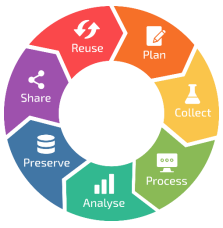Data Management Plan
DMP is a document that describes the "life cycle" of data throughout the entire project. It specifies how the data will be collected, processed, analysed, described, preserved, shared and, where appropriate, reused. The DMP also specifies the metadata and all ethical and legal aspects, as well as the data storage and back-up facilities and, finally, all the responsible parties and resources.
The following illustration shows the data lifecycle management:

© ELIXIR RDMkit
- Plan: Not only a plan for working with data, but a plan of the whole project. We determine what data we will work with; if it is external, what kind of license it is under, whether it is sensitive data, how and for how long it will be archived and – last but not least – how the data work will be funded.
- Collect: Collecting the data, for example through questionnaire surveys, outputs from own measuring instruments and computers, etc.
- Process: This can be merging of the data, converting it into a consistent format and/or cleansing it.
- Analyse: The research work with data itself. At this stage, the scientific output suitable for publication is created. More often, the datasets on which the published article is based are also a part of the output.
- Preserve: Because of sharing and reusing the data are stored in a reliable repository. Data are given a persistent identifier (for example DOI) so that they can be uniquely linked to.
- Share: The identifiers allow other users to access the data, for example to check their published results or compare the data with their own outputs.
- Reuse: The stored data can be used for further research by the original author and/or by other scientists in the discipline.
More about working with the data lifecycle can be found HERE. This is not a one-time activity, but a long-term process that needs to be continuously monitored and maintained throughout the data lifecycle.
Planning data work
At the beginning of the project there starts a process of planning the procedures and communication of the data lifecycle. It is necessary to plan all activities related to the handling of data during scientific research. And the result is a living document: Data Management Plan.
The plan is primarily a tool for all scientists involved in research. It can be used whenever there is a need to track down any data or the exact procedure of obtaining it. It is useful when a new member joins the research team or when the circumstances of a research project change in any way.
DMP may be an obligation and condition of some funders who require to store, share and publish data (e.g. OP JAK, Horizon Europe or other fund providers). Such a plan is also a reliable way how to how to verify the progress and conclusions of the research at the end of the project. Therefore, some funders make it a mandatory requirement to submit a DMP at the beginning, during and at the end of the project.
The plan does not have to be project-specific but can describe the handling of research data at the level of the whole organisation.
Data Management Plan development tools
Data Stewardship Wizard
An excellent and sophisticated online tool for creating DMPs, the web page can be visited HERE. The program will help with the formal creation of the plan, but in addition it will make sure that the data is FAIR and will take care of its machine workability. DSW will allow sharing within the team and highlight any conflicts. It is also well prepared for possible changes during the course of the project.
A detailed user manual in English can be found HERE.
DMPonline
Probably the oldest tool for creating a DMP. This online application has a web page HERE and the DMP creation is based on replying form questions. HERE are also publicly available examples of plans from various previous projects and HERE are some requirements of different grant agencies. These are considered unofficial so they should be always checked directly with the funders.
Argos
Web application with a homepage HERE also helps to create a DMP using your answers to questions. However, Argos separates the project plan and the description of the dataset, so it can be used in other projects, too. In addition, Argos is linked to OpenAIRE and EOSC and allows the DMP to be stored in the Zenodo repository (more on the repository can be found HERE). Examples of completed plans can be viewed HERE and dataset samples are shown HERE.
DMP Format
Data Management Plan does not have a fixed mandatory form. There are different free templates available, for example DMP Horizon (bilingual text in Czech and English in MS Word / PDF format) HERE.


